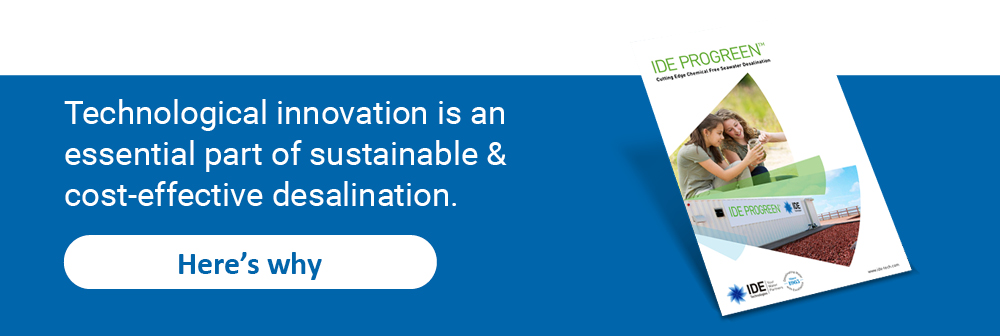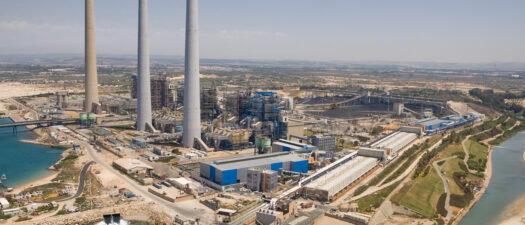As the demand for freshwater intensifies globally, desalination has become an essential technology for addressing water scarcity. However, the disposal of brine,.
Desalination Has No Known Negative Impacts on the Environment: True or False?

Although historically desalination has had negative impacts, newer sustainable methods of desalination are emerging. Sustainable, eco-friendly and cost-effective desalination doesn’t begin and end with technological advancement. Its scope needs to stretch beyond traditional limits for it to offer a genuinely comprehensive solution in a reality of increasing uncertainty regarding climate and natural resources. Let’s take a look at the ecological and economic significance of pairing eco-friendly desalination with renewable energy resources & responsible effluent management, that together ensure a truly sustainable water future.
The Needs & Challenges
Water scarcity is a worldwide issue. Today nearly 700 million people worldwide suffer from water shortage, and that number is expected to grow to 1.8 billion in just 10 years (source: The United Nations). While seawater and brackish water desalination offer an alternative to rising water demands associated with population growth, diminishing water supplies and contamination, desalination can clearly provide a sustainable water source, but at the same time poses some challenges when not implemented properly.
The need for sustainable solutions is clear. Water demand is increasing worldwide as a result of growing populations, agricultural intensity and industrial development, while increasing climate fluctuation is disrupting natural patterns of precipitation and water storage. But what exactly do we mean when we talk about environmentally-conscious desalination? Do we look at desalination technologies? Their source of energy? Desalination byproduct discharge and disposal methods? The most responsible, although quite intricate answer would be – all of the above.

While technological advancements that enable lower carbon footprint desalination are currently available, or in various stages of development (e.g. RO-PRO), according to a recent study by the United Nations Environmental Program, brine discharge and high energy consumption are by far the most environmentally-challenging aspects of desalination.
Reports such as “Low Carbon Desalination” – the result of a 2016 workshop conducted at MIT that involved experts from 11 nations – marked one of several recent global initiatives attempting to drive down the carbon footprint of desalination by coming up with practical solutions. Conservation and reuse efforts have helped moderate the demand for new freshwater resources in some locations, and desalination is increasingly being used to meet demand worldwide. Currently installed capacity is almost 100 million m3/day of desalinated water, a value that has been growing rapidly, with growth projected at 12% over the next five years.
Desalination is a very efficient way to transform substantial quantities of seawater into high quality fresh water for municipal, agricultural or industrial use. That being said, it is an energy-intensive process. In most cases, energy consumption accounts for more than a 1/3 of the cost of water in modern plants, driving renewable energy sources to become a major component of more environmentally-minded desalination. Currently, although renewable energy is not likely to reduce the cost of desalination in terms of the initial investment, it is likely to do so in the long run, primarily by bringing down ongoing operational costs.
<< Read more about sustainable technological innovation >>
Can the energy consumption of desalination be reduced?
According to a growing body of studies – the answer is a resounding YES, and energy-efficient alternatives to fossil fuel are already available at hand. Energy requirements account for 33%-50% of the total cost of desalinated water, according to the “Renewable Energy Desalination” report issued by The World Bank.
In the case of Reverse Osmosis (RO), although energy consumption has already decreased almost 10 fold since the 1970s, and despite the fact that more energy-efficient innovations in pretreatment, membrane design and energy recovery devices were introduced in the mid-90s, energy still comprises 33% of the total annual costs for SWRO. For this reason, reducing energy consumption or using renewable energy sources would be among the most effective ways of bringing down the overall cost of desalination from a long-term perspective.
Among currently available renewable energy sources that offer more sustainable alternatives to traditional fossil fuel-based energy sources are: Solar Power, Hydroelectric Power, Wind Power, Geothermal Power and Biomass Power. These energy sources have their advantages – such as abundant availability where applicable, low carbon footprint and in most cases lower OPEX, but also disadvantages – such as geography-based limitations and high CAPEX.
In order to become more commercially viable, pushing renewable energy sources forward will require strategic support such as energy policy reforms designed to eliminate barriers, e.g. eliminating fossil fuel subsidies, creating the enabling environment for meaningful regulatory changes and much needed investments in R&D. Once implemented, renewable energy-based desalination will be substantially more economical and cost-effective.

What About Brine Discharge?
Desalination processes result in two streams – product and brine/reject. Brine management and disposal, especially for inland applications, is currently one of the most pressing issues associated with water treatment. Disposal methods are diverse, and depend on concentrate quantity and quality, permitting requirements, costs, local environmental regulation, geography and geology (e.g. accessibility to ocean or sewer, land availability, appropriate geological formation for deep well injection etc.). Given the bureaucratic complexity of brine disposal, converting brine from potentially harmful waste into a resource through proper treatment is the ideal way to minimize costs and environmental impact.
Brine production is estimated to be around 142 million m3/day, and its quantity and quality depends on the source water quality, pretreatment, desalination processes implemented and water recovery (i.e. ratio of permeate flow and feed flow). As water recovery increases, the concentration of dissolved solutes in the concentrate stream might exceed the solubility of sparingly soluble salts (e.g. CaCO3, CaSO4, SiO2 and BaSO4) and precipitation can occur. These precipitates, together with colloids, organic matter and bacteria can foul membrane and system surfaces, reduce process efficiency and limit water recovery. To address this – acid, scale inhibitors and disinfectants are usually added to the feed or concentrate streams (Source: “Critical Review of Desalination Concentrate Management, Treatment and Beneficial Use”).

But water recovery isn’t limited just by fouling or scaling. Another major component is the osmotic pressure of the highly concentrated brines, which causes trans-membrane pressure to exceed design tolerance of the membrane. Currently, the typical water recovery of seawater reverse osmosis (SWRO) systems varies between 40% to 50%, meaning that 50-60% of the feed stream is rejected as brine. Brackish water reverse osmosis (BWRO) desalination plants typically operate at recoveries of 75% to 85%, but occasionally some plants operate at only 50-60% due to scaling or energy saving considerations (Source: “Critical Review of Desalination Concentrate Management, Treatment and Beneficial Use”). As expected, higher recoveries lead to higher desalination costs, because they often involve energy-intensive methodologies such as thermal processes.
Recovery enhancement can improve sustainability in a number of ways:
![]() Provide an additional freshwater resource (by turning seawater or contaminated water into potable water)
Provide an additional freshwater resource (by turning seawater or contaminated water into potable water)
![]() Decrease the volume of waste for disposal
Decrease the volume of waste for disposal
![]() Facilitate the extraction of valuable salts from the brine – raising economic opportunities such as commercial salt extraction, metal recovery and the use of brine in canned fish production systems
Facilitate the extraction of valuable salts from the brine – raising economic opportunities such as commercial salt extraction, metal recovery and the use of brine in canned fish production systems
Salt extraction is preferable from an environmental point of view, and forecasts predict that it is likely to become more common in the coming years. It has also been shown that in the case of SWRO produced brine, the extraction of many salts such as chlorine, bromine, sodium hydroxide, calcium carbonate, magnesium hydroxide and magnesium oxide – is technically feasible. According to the WateReuse Research Foundation, the main factors that impede salt recovery from seawater desalination brine are the economics of extraction, followed by facility location, product purity, staffing, safety, material handling and storage.
As evident – solutions are currently available, but the lack of both economically and ecologically feasible brine management options is a major barrier to a more widespread implementation of desalination solutions. In the case of BWRO – some options, such as evaporation ponds or surface water discharge (into lakes, oceans, rivers etc.) are cost-effective but could pose a serious environmental hazard. Other options, such as deep-well injection, are both costly and potentially harmful due to the risk of leakage into nearby aquifers, while solutions such as Zero Liquid Discharge (ZLD) treatment are eco-friendlier but could be costly, depending on specific requirements and the technology of choice.
<< Read more about our sustainable solutions >>
Responsible Technological Advancements
Are there eco-conscious brine minimization solutions that are also financially viable? And in what ways can technology enable enhancement of water recovery, removal of organic contaminants and recovery of valuable products and energy?
Here at IDE, we don’t believe in having to choose between protecting the environment and offering a solution that makes financial sense. Our line of smart, innovative and cost-effective solutions is designed to address all business, operational, budgetary and regulatory requirements, while ensuring a minimal impact on the environment. Here is a quick review of two of our leading eco-friendly solutions:
ZLD – Provides a complete closed loop cycle where effluents are recycled and reused, discharge is eliminated and environmental regulations are complied with in full. For more information about the applications of ZLD, current landscape and all aspects of zero liquid discharge, see our recent blog post on ZLD – The Race to Zero is On.
IDE PROGREENTM™ – a unique SWRO desalination technology that utilizes a patented DOC technology, IDE PROGREENTM is based on a natural bio-flocculation process, is chemical and antiscalant-free and does not require chemical cleaning. From an economic perspective, this technology enables up to 10% reduction in OPEX thanks to reduced energy consumption, minimal maintenance and savings on chemicals (which account for about 20% of yearly operational expenses).

Another aspect that contributes to the cost-effectiveness of this solution is its availability in a modular configuration, which shortens installation time and minimizes on-site construction work.
IDE PROGREENTM is regulation-friendly, enabling a shorter permitting process and eliminating the need for chemical disposal permits. To learn more about our chemical-free pretreatment and Direct Osmosis Cleaning (DOC), see the link below.
Conclusion
Sustainability needs to be engrained into every aspect of our lives for us to ensure the future of our planet, and it is the responsibility of our governments, industries and each and every one of us to apply daily steps to minimize our carbon footprint, salvage our natural resources from destruction and regain our planet’s fragile ecological balance. Unfortunately, global water shortage, rising populations and increasingly polluted water sources are already an alarming reality, and it has already been proven that desalination offers a uniquely effective alternative to dwindling natural resources. This doesn’t mean that desalination or its accompanying aspects can’t be improved to meet today’s environmental demands in full. Our industrial landscape is still a long way from being ecologically harmless, and there’s much that needs to be done on the technological and regulatory fronts to support this goal.
In the meantime, let’s make responsible choices regarding the technology we implement today. Let’s asses all facets of the solutions we adopt, which include their energy source, consumption and reuse, as well as their industrial output, treatment and recovery. At the end of the day, sustainability is good business and plain logic. Businesses that choose to incorporate environmentally-aware, financially-responsible and resource-effective measures will ensure their continuation, while businesses that do not – are not likely to stand the test of time.

Sources
- “Towards sustainable desalination”, Birguy Lamizana, United Nations Environmental Program, May 2019
- “Renewable Energy Desalination” report issued by The World Bank
- “Low Carbon Desalination – status and research, development and demonstration needs” – report of a workshop conducted at the MIT in association with the Global Clean Water Desalination Alliance, October 17-18, 2016, Food Security Laboratory (J-WAFS), Abdul Latif Jameel, World Water
- “Critical Review of Desalination Concentrate Management, Treatment and Beneficial Use”, Pei Xu, Tzahi Y. Cath, Alexander P. Robertson, Martin Reinhard, James O. Leckie and Jorg E. Drewes, ENVIRONMENTAL ENGINEERING SCIENCE, Volume 30, Number 8, 2013


















